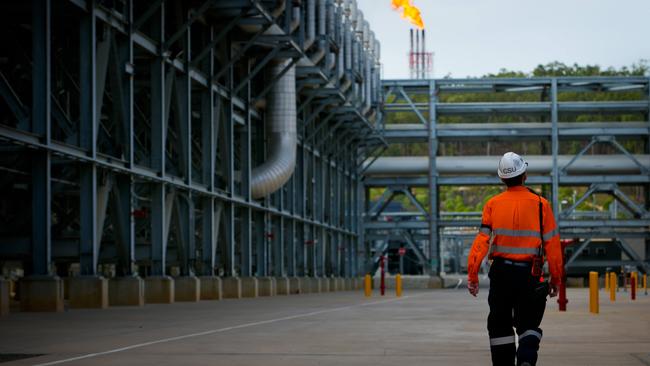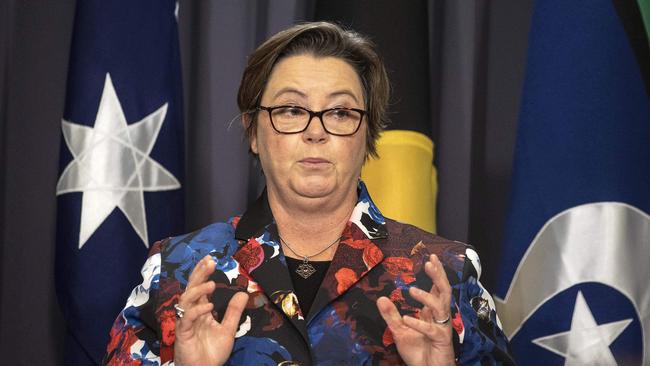Gas giants cash in with record earnings and even greater numbers to come
Australia’s under-fire gas producers earned the most from LNG exports on record in 2022 and a fresh high is tipped for this year.

Australian gas producers are set to break their export supply record in 2023 after reaping $90bn in earnings last year – an all-time high – amid moves by the Albanese government to clamp down on the industry.
The nation’s LNG projects shipped 81.5 million tonnes of gas overseas in 2022, marking a record, but that could be bettered by a further million tonnes to 82.5 million tonnes in 2023, government commodity forecasts show.
A pricing surge last year, in part triggered by Russia’s invasion of Ukraine, resulted in the nation’s LNG export earnings reaching $90bn in 2022, which was up 82 per cent on the previous year, and the highest annual figures ever generated for Australian shipments of the fossil fuel.
Export earnings are forecast to reach $91bn in the 2022-23 financial year, driven by elevated spot LNG and oil price-linked contract prices, and high gas production, allowing Australia’s producers to sell more of their output at spot market prices.
“Prices remain higher than before the war in Ukraine, and sensitive to ongoing developments. Russia – a leading global energy exporter – remains locked out of large parts of the global market, with ongoing impacts expected for global thermal coal and LNG supply,” a quarterly report released by the Department of Industry, Science and Resources says.
The contribution of the LNG sector is forecast to turbocharge Australia’s overall resources and energy exports to a record $464bn in 2022–23.
While officials expect LNG export earnings to eventually halve to $45bn by 2027-28 as prices ease and volumes steady, the revenue bonanza may embolden Prime Minister Anthony Albanese as he weighs up a further series of interventions and imposts on the energy sector.
Labor has the industry on edge with a move to revamp the gas industry’s code of conduct to cut prices, while Resources Minister Madeleine King could pull the trigger on limiting exports from the three Queensland LNG projects within weeks in order to bridge a potential domestic shortfall.

The federal government is also considering strengthening the Petroleum Resource Rent Tax, which taxes profits generated from oil and gas commodities. Treasurer Jim Chalmers last year reactivated a review that had been shelved during the pandemic.
Gas companies are dealing with a $12 per gigajoule price cap on the sale of domestic supplies, while big producers such as Santos, face threats from a redesigned “safeguard mechanism”, agreed under the deal struck between the federal government and the Greens.
LNG prices are forecast to stay “elevated and volatile” until 2025 as markets continue to be tight following the stranding of Russian pipeline gas supply previously destined for Europe.
Despite forecasts of a record export haul this year, Australia is forecast to soon lose further market share to its two biggest rivals, Qatar and the US.
Both Australia and Qatar have been jostling for pole position in recent years, while the US has also started to export more LNG at times, thanks to access to low-cost supplies that can be shipped to buyers in Asia.
US LNG production is forecast to grow to 93 million tonnes by 2025, according to the report, and 134 million tonnes by 2028. Australia, in contrast, will remain steady at 82 million tonnes through much of the decade.
Qatar has plans to add an extra 42 per cent of capacity, taking its output to 110 million tonnes a year.
Qatar Petroleum will add four LNG trains, each with 8.25 million tonnes of capacity, equivalent to more than twice the capacity of Australia‘s largest export facility, the North West Shelf LNG plant in Western Australia.
Government commodity forecasters have also marked out the rise of lithium this decade as a significant trend, and the battery-making material is expected to deliver a big jump in annual earnings to the same level as thermal coal.
“Lithium faces a particularly strong outlook, with earnings expected to surge from $5bn in 2021-22 to $19bn in 2022-23 and remain at $19bn in 2027-28 – as the impact of falling prices is offset by rising production volumes,” the report says.
“Global demand for thermal coal has passed its peak, and most proposed thermal coal-fired power plants now cancelled around the world.
“Falling prices are expected to reduce thermal coal earnings from $65bn in 2022-23 to $19bn by 2027-28.”
Metallurgical coal, used for steelmaking, also faces a revenue slide over the decade.
“Metallurgical coal prices rose as supply was impacted by flooding in Australia and sanctions on Russian exports, but a return to more typical prices is projected to drive a decline in export earnings from $63bn in 2022-23 to $30bn by 2027-28.”
While commodity prices have receded from 2022 records, the report said a surge in Chinese demand could again result in a spike from current levels.


To join the conversation, please log in. Don't have an account? Register
Join the conversation, you are commenting as Logout